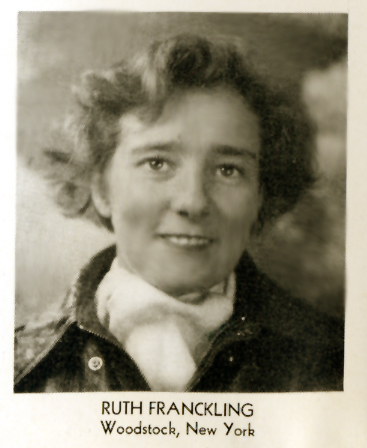Ruth (Franckling) Reynolds of Woodstock, NY, was the envy of all red-blood youngsters all over the nation when she was one of the select 1000 women picked to pilot Uncle Sam’s biggest and swiftest military planes.
Ruth took flying lessons at the Kingston Airport, soloed in August of 1940 and earned her Private Pilot’s license in October. She got her flying time at a reduced rate; she rushed out early each morning when weather permitted, working as line-chief, getting planes lined up and gassed for the day’s schedule before rushing back to Woodstock to help in her father’s diary store.
Ruth earned her Commercial License in October of 1941. She was the first female in Ulster County to have this rating. She earned her Instructor’s Rating in January of 1942 and instructed at Kingston for the remainder of the year, building a total of about 700 hours of flying.
When Jacqueline Cochran put out a call for women to serve as Women’s Air Force Service Pilots for ferrying planes, teaching rookie pilots and towing targets for gunnery practice, Ruth’s credentials as a civilian pilot impressed her.
After six months of training in Houston, Texas, which started in December 10, 1942, she went the rounds of seven increasingly difficult training schools during 1943 and 1944, mastering instrument flying, multi-engine training and pursuit transition.
As a ferry pilot, she flew brand-new warplanes from the assembly line to a point from which they would be flown overseas. Ruth became qualified to fly nineteen different military planes – types that most people would only see in the movies. These were the L-2 and L-5 observation planes, the PT-19, BT-6, AT-6, AT-19 and the AT-10 trainers. She was also qualified to fly the C-78 transport, C-47 troop carrier, B-25 medium bomber, the A-20 attack bomber and the hot fighter planes –the P-40. P-39, P-63, P-51 and P-47 – quite an accomplishment for a girl who was 23 years old!!
Ruth was based in Palm Springs, California. A typical week for her was to gas up a P-51 Mustang, fly 10 hours to Newark, NJ—hop a flight to Niagara Falls, pick up a P-39 at Bell Aircraft Factory and fly eight and one-half hours to Great Falls, Montana, hitch a ride to Long Beach or Palm Springs, and start all over.
|
The WASP were not permitted to fly overseas or allowed to fly in a fighter after dusk-instrument flying was not allowed. The fighters had auxiliary belly or wing gas tanks that could keep them airborne for 2 1/2 to 4 hours, depending on the type of plane. The pilots stopped for gas every two and a half-hours or for an overnight stay to break up the long trip.
Only twice did Ruth experience trouble: once after having her flight of several P-51 Mustangs mysteriously grounded for two days at Tulsa, Oklahoma, the women were finally given the green light for take-off. Ruth was one of the first to line up on the 2500-foot runway and pushed the throttle forward. The plane lifted and she was about to lift her gear when the engine quit. Heading at over 150 miles an hour toward an administration building, gas trucks and a crowd at the end of the runway, Ruth set the plane back down and wore the tires down to the wheel hubs, finally stopping short of the dispersing crowd. The aborted flight solved the mystery of why the flights were held for two days. It confirmed there was water mixed with the gas in the field’s underground gas tanks.
The other close call came while flying a P-63 at 8,000 feet over St. Paul, Minneapolis and going through the procedure for switching gas tanks. Again—a dead engine! Diving to get the windmilling prop to restart the engine, Ruth kept going on gas remaining in the main tank for safe landing at Fargo, North Dakota. She soon discovered the ground crew at Niagara Falls had neglected to remove plugs in the wing tanks that would allow gas to flow freely.
In spite of these hectic moments, Ruth loved every bit of her assignment and was bitterly disappointed when the program ended in December 1944. The WASP’s offered to stay on at $1 a year, but the government wasn’t interested.
Ruth went back to instructing and flying charter runs in Kingston. In 1946 she and Ward Reynolds were married. Ward, a veteran of service in the 11th Airborne Division, was also a pilot and the pair opened a flying service, with two Piper Cubs, off a farm lot in Halcott Center, New York.
______________
Tribute to Ruth
From Ruth's daughter Nancy Reynolds: I would like to add my amazing and wonderful mother to the list of her friends and aquaintences on your "Final Flight" page. Sadly, she passed away on on May 15, 2007. She was an inspiration to everyone who was fortunate enough to know and love her and our family is happy that you help keep her legacy alive. I'm attaching some information - thank you for your wonderful website and dedication to true heros. Sincerely, Nancy |
